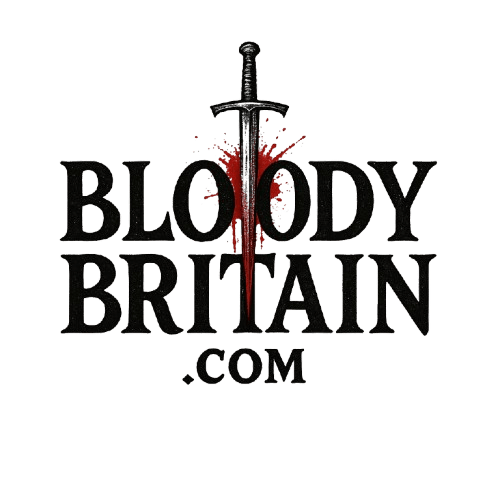Hollywood gave us Braveheart. Mel Gibson in war paint, freedom speeches, slow-motion charges across the heather. Stirring stuff — but clean, palatable, and wrapped in the myth of noble resistance.
The truth? The First Scottish War of Independence (1296–1328) was hell on earth. A meat grinder of scorched villages, mutilated corpses, famine, betrayal, and cruelty on a scale that would shame even the bloodiest of medieval campaigns.
”Edward I didn’t see Bruce as a king, but a traitor. No chivalry. No mercy. Just the cold mechanics of empire.”
This wasn’t some honourable clash of rival kings. This was a war of annihilation. A long, bitter death spiral between two peoples who knew the land was only big enough for one master.
Let’s dig beneath the legend — into the mud, the rot, and the bone.
Edward’s Total War: Burn Everything, Starve Everyone
Edward I, the ‘“”Hammer of the Scots,” wasn’t a romantic tyrant. He was a tactician of terror.
After invading in 1296, Edward didn’t just defeat Scottish forces; he aimed to erase Scotland as a functioning nation. His armies burned abbeys, salted fields, slaughtered livestock. They razed towns like Berwick-upon-Tweed where, in one day, his troops murdered between 7,000 and 15,000 civilians, slicing down men, women, children, even monks inside churches.
Edward’s logic was brutal: no food, no homes, no resistance. He intended to leave Scotland a smouldering carcass that couldn’t rise again.
And it almost worked.
Wallace’s Revenge, And Brutality of His Own
William Wallace gets the Hollywood halo, but in reality, the man was forged by massacre and paid it back in kind.
After the Battle of Stirling Bridge in 1297, Wallace’s forces swept south into Northumberland and Cumberland, leaving a trail of blood behind them. English chroniclers wrote of burned villages, raped women, mutilated prisoners, and entire communities reduced to ash.
In one case, Wallace reportedly ordered English prisoners flayed, their skins nailed to walls as a warning. To the English, he was a butcher. To the Scots, a deliverer. Either way, the war turned him into something inhuman.
The Execution of Wallace: A Public Spectacle of Pain
Wallace’s capture in 1305 didn’t end with a clean sword to the neck. Edward wanted a message written in blood.
He was dragged naked through London streets, hanged until half-dead, castrated, disembowelled alive, his guts burned before his eyes, then finally beheaded and quartered.
”Remember the real cost. It’s not a speech. It’s not a statue. It’s what’s buried beneath the heather; bones with no names, rotting in the peat, still waiting for the war to end.”
His head was stuck on a spike above London Bridge. His limbs were sent to Newcastle, Perth, Stirling, and Berwick nailed up like road signs of English domination.
That wasn’t justice. That was ritual humiliation. And it burned itself into Scottish memory like a brand.
Robert The Bruce’s Darkest Deed: Betrayal in a Church
Robert the Bruce is another name soaked in legend. The noble rebel, the unifier. But even Bruce had blood on his hands — most infamously in 1306.
In a desperate bid for the crown, Bruce killed his rival John Comyn inside the Church of the Greyfriars in Dumfries, not in battle, but at the altar.
It was considered both murder and sacrilege, and it split the Scottish nobility. But Bruce doubled down, had himself crowned king, and waged a war of near-constant retreat and brutal guerrilla strikes , more bandit king than crowned ruler.
The Massacre at Methven, English Treachery
In 1306, Bruce’s forces were caught in their tents near Methven, ambushed at dawn under a supposed truce. Hundreds of his knights were slaughtered in their sleep. Those captured were executed without trial: hanged, drawn, and quartered.
It was a warning: Edward I didn’t see Bruce as a king, but a traitor. No chivalry. No mercy. Just the cold mechanics of empire. The war slipped deeper into barbarity after that. Trust died. Every skirmish became a kill-or-be-killed affair.
Collateral Famine: The Civilian Body Count
While knights clashed and kings plotted, ordinary Scots and English border folk endured the unspeakable. Entire regions were reduced to famine-stricken wastelands.
Livestock were seized or butchered, crops trampled by armies, and winter often arrived with no food stores left. Cannibalism is mentioned in some chronicles, particularly in the Highlands and border towns.
Bands of deserters and brigands roamed the hills, looting what little remained, often butchering children or the elderly for scraps. The nobility might write the history but it’s the peasants who paid in screams and silence.
The War Didn’t End, It Just Got Quieter
The First War of Independence officially ended in 1328 with the Treaty of Edinburgh-Northampton, recognising Scotland’s sovereignty under Bruce. But peace was a fragile illusion.
Within four years, Edward III would reject the treaty. Civil war would erupt again. Bruce’s son, David II, would be forced into exile. Edward Balliol, a puppet king, would invade with English backing. The blood never stopped flowing. It just flowed in different rivers.
What we call the “Second War of Independence” was really just the aftershock of the first. Proof that when you burn a nation, the embers last generations.
Final Thoughts: The Price of “Freedom”
The First Scottish War of Independence wasn’t a clean war. It wasn’t noble. It was mud, fire, and suffering. Men flayed, families starved, cities gutted.
Both sides committed atrocities. Both believed they were righteous. But the truth is, wars like this don’t have heroes, just survivors.
So next time you hear someone shout “freedom!” with a flag in their hand and a slogan on their lips, remember the real cost. It’s not a speech. It’s not a statue. It’s what’s buried beneath the heather; bones with no names, rotting in the peat, still waiting for the war to end.


